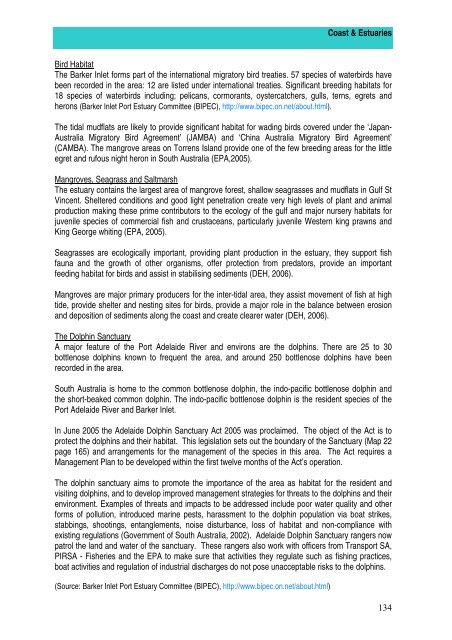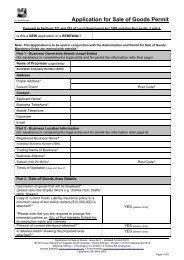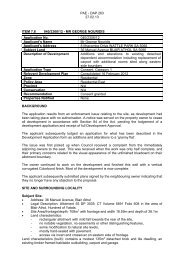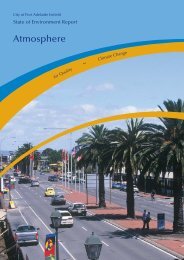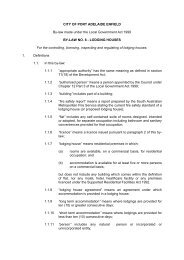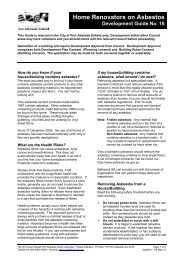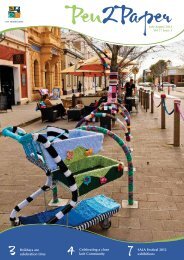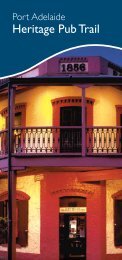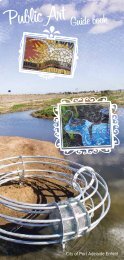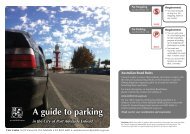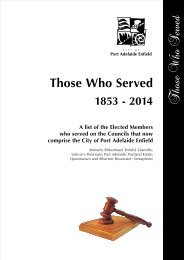Coasts & Estuaries - City of Port Adelaide Enfield - SA.Gov.au
Coasts & Estuaries - City of Port Adelaide Enfield - SA.Gov.au
Coasts & Estuaries - City of Port Adelaide Enfield - SA.Gov.au
You also want an ePaper? Increase the reach of your titles
YUMPU automatically turns print PDFs into web optimized ePapers that Google loves.
Coast & <strong>Estuaries</strong>Bird HabitatThe Barker Inlet forms part <strong>of</strong> the international migratory bird treaties. 57 species <strong>of</strong> waterbirds havebeen recorded in the area: 12 are listed under international treaties. Significant breeding habitats for18 species <strong>of</strong> waterbirds including; pelicans, cormorants, oystercatchers, gulls, terns, egrets andherons (Barker Inlet <strong>Port</strong> Estuary Committee (BIPEC), http://www.bipec.on.net/about.html).The tidal mudflats are likely to provide significant habitat for wading birds covered under the ‘Japan-Australia Migratory Bird Agreement’ (JAMBA) and ‘China Australia Migratory Bird Agreement’(CAMBA). The mangrove areas on Torrens Island provide one <strong>of</strong> the few breeding areas for the littleegret and rufous night heron in South Australia (EPA,2005).Mangroves, Seagrass and SaltmarshThe estuary contains the largest area <strong>of</strong> mangrove forest, shallow seagrasses and mudflats in Gulf StVincent. Sheltered conditions and good light penetration create very high levels <strong>of</strong> plant and animalproduction making these prime contributors to the ecology <strong>of</strong> the gulf and major nursery habitats forjuvenile species <strong>of</strong> commercial fish and crustaceans, particularly juvenile Western king prawns andKing George whiting (EPA, 2005).Seagrasses are ecologically important, providing plant production in the estuary, they support fishf<strong>au</strong>na and the growth <strong>of</strong> other organisms, <strong>of</strong>fer protection from predators, provide an importantfeeding habitat for birds and assist in stabilising sediments (DEH, 2006).Mangroves are major primary producers for the inter-tidal area, they assist movement <strong>of</strong> fish at hightide, provide shelter and nesting sites for birds, provide a major role in the balance between erosionand deposition <strong>of</strong> sediments along the coast and create clearer water (DEH, 2006).The Dolphin SanctuaryA major feature <strong>of</strong> the <strong>Port</strong> <strong>Adelaide</strong> River and environs are the dolphins. There are 25 to 30bottlenose dolphins known to frequent the area, and around 250 bottlenose dolphins have beenrecorded in the area.South Australia is home to the common bottlenose dolphin, the indo-pacific bottlenose dolphin andthe short-beaked common dolphin. The indo-pacific bottlenose dolphin is the resident species <strong>of</strong> the<strong>Port</strong> <strong>Adelaide</strong> River and Barker Inlet.In June 2005 the <strong>Adelaide</strong> Dolphin Sanctuary Act 2005 was proclaimed. The object <strong>of</strong> the Act is toprotect the dolphins and their habitat. This legislation sets out the boundary <strong>of</strong> the Sanctuary (Map 22page 165) and arrangements for the management <strong>of</strong> the species in this area. The Act requires aManagement Plan to be developed within the first twelve months <strong>of</strong> the Act’s operation.The dolphin sanctuary aims to promote the importance <strong>of</strong> the area as habitat for the resident andvisiting dolphins, and to develop improved management strategies for threats to the dolphins and theirenvironment. Examples <strong>of</strong> threats and impacts to be addressed include poor water quality and otherforms <strong>of</strong> pollution, introduced marine pests, harassment to the dolphin population via boat strikes,stabbings, shootings, entanglements, noise disturbance, loss <strong>of</strong> habitat and non-compliance withexisting regulations (<strong>Gov</strong>ernment <strong>of</strong> South Australia, 2002). <strong>Adelaide</strong> Dolphin Sanctuary rangers nowpatrol the land and water <strong>of</strong> the sanctuary. These rangers also work with <strong>of</strong>ficers from Transport <strong>SA</strong>,PIR<strong>SA</strong> - Fisheries and the EPA to make sure that activities they regulate such as fishing practices,boat activities and regulation <strong>of</strong> industrial discharges do not pose unacceptable risks to the dolphins.(Source: Barker Inlet <strong>Port</strong> Estuary Committee (BIPEC), http://www.bipec.on.net/about.html)134


